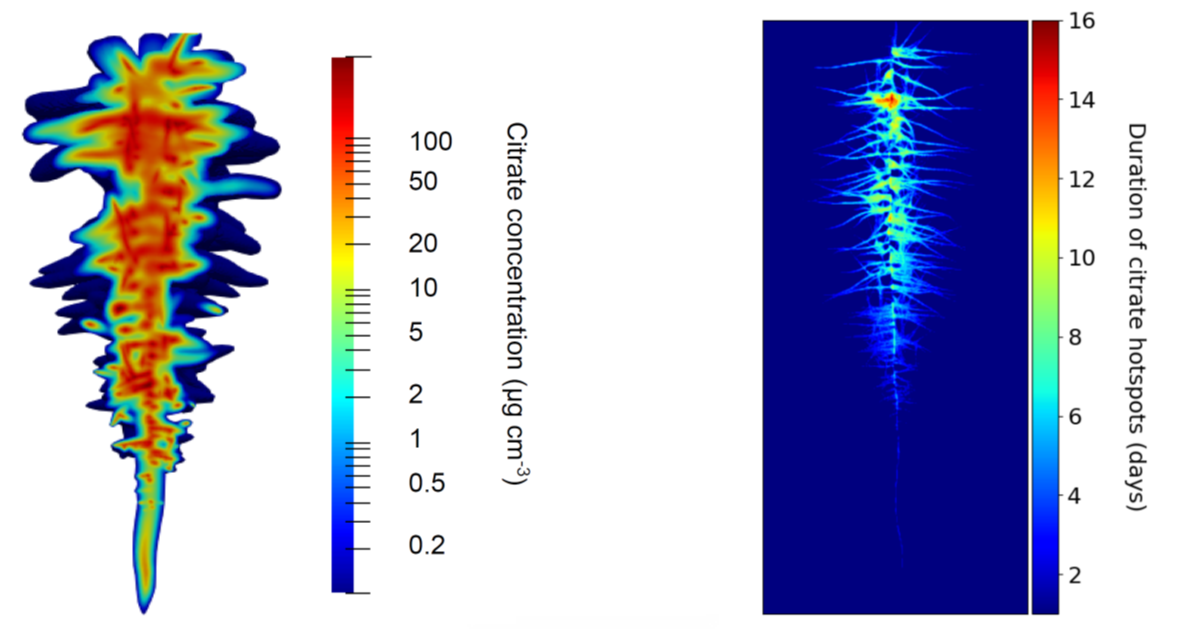P24 - Rhizosphere Modelling
Modelling self-organisation in the rhizosphere

All resources plants acquire from soil have to pass through the rhizosphere, i.e., that part of the soil in the vicinity of the roots that is influenced by root activities. This results in particular in radial gradients between root surface and bulk soil which are additionally shaped by the interplay of several interacting components (soil, roots, microorganisms, chemicals). The overall objective of this project is to use multiscale modelling to study the interplay between root architecture development and gradients of various rhizosphere components simultaneously. In our multiscale approach, we consider 1D radially symmetric rhizosphere gradients around each individual root segment and can thereby achieve a resolution much higher than the one at which the root system architecture is defined. Flow and transport are computed on both scales and coupled in a mass conservative way. This approach has proved to be accurate at reasonable computational cost, thus facilitating consideration of multiple components.
We will implement our models using the root architecture model CRootBox and DuMux, a simulator for flow and transport modelling in porous media. The models will be parameterised and evaluated based on experimental data acquired by different collaborating projects, including structural data on both root architecture and soil, data on plant water relations, exudates and nutrients as well as microbes in the rhizosphere. Our model results will contribute to the understanding of the rhizosphere as a self-organised system. In particular, we aim to predict parameter regimes in which different patterns represent stable, resilient systems.
Outcome
In a first study by
Schnepf et al. (2022)
, we have shown that current modelling tools are able to represent interacting processes in the rhizosphere that determine characteristic properties of plants such as root growth, transpiration, nutrient uptake or carbon storage in the soil. Particular attention was paid to how the models link the different scales at which these processes take place.
For our modelling studies, we need root architecture parameters that allow the simulation of root systems that correspond to the actual root systems in the field. For this purpose, a master thesis (Francis et al., 2024) was conducted, in which photos of root systems visible on the transparent front plate of root windows installed in the field (P11: E. Oburger) were taken at constant time intervals throughout the growing season. By combining these photos with novel image analysis tools, root architecture parameters were derived that can be used as input parameters in the root architecture model CPlantBox.
It is known that root architectures can only be incompletely reconstructed from images of non-invasive imaging techniques (X-ray CT, MRI), as roots with small diameters are not visible on these images. In an ongoing book project (Pohlmeier et al., in preparation), we present a new method of virtual root augmentation in which missing roots are added by modelling to a root architecture scaffold reconstructed from MRI images. This virtual augmentation method is not only able to correct the missing root length, but also to reproduce the original root architecture in 3D space, which is necessary for correct results when simulating root water and nutrient uptake
In a recently submitted study (Lippold and Landl, submitted), we combined experimental measurements (micro-X-ray fluorescence spectroscopy and X-ray computed tomography) with a process-based, radially symmetric 1D rhizosphere model to evaluate the effects of root type and age, radial root geometry, and root hairs on nutrient gradients in the rhizosphere. We could show that root hairs matter for nutrient uptake during supply limitation (phosphorus), but not when it is limited by uptake kinetics (calcium and sulfur) and that higher calcium and sulfur accumulation occurs on the surface of older and thicker root segments than on younger and thinner ones.
In an ongoing study (Landl et al., in preparation), we use a multiscale modelling approach and extensive experimental field data, including data on root architecture as well as on total plant exudation rates and exudation dynamics of individual roots, to investigate the spatio-temporal evolution of root exudate patterns in soil around growing three-dimensional root systems. This approach follows on from the publication by
Landl et al. (2021)
, in which we investigated the occurrence of exudate hotspots around growing root systems as a function of root architecture development. Our new approach now additionally allows us to investigate the effects of water conditions in the soil-root system on exudate distribution patterns in the field based on measured data.
Link to English
scientific abstract
Link to German
scientific abstract
